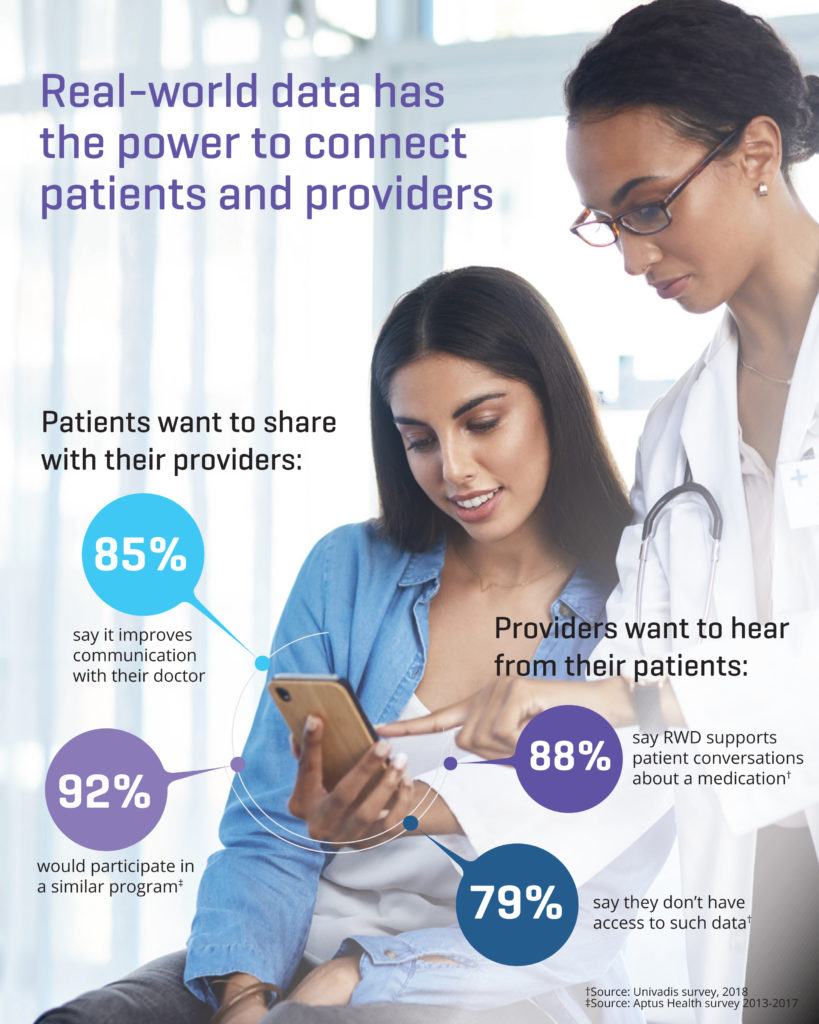Big data is changing the way pharma manufacturers approach their product and marketing efforts. The ability to generate and apply insights from these data is key to strategic planning, including the design of promotional efforts to engage target audiences with relevant messages.
Yet there is still great opportunity for what could be called “smaller data”—those more intimate insights that can only be gained by understanding how people engage with and respond to a branded therapy in the real world.
These real-world data (RWD) are gaining traction as a viable and valuable currency. According to a Deloitte Insights report, 90% of survey respondents in the life sciences industry are now building their real-world data capabilities, driven in part by the need to better understand the patient journey. Let’s take a look at some of the ways that capturing the “voice of the patient” can support real-world impact for pharma marketers.
From Clinical Trials to the Real World
For all the valuable data they offer, the controlled environments of a clinical trial setting aren’t necessarily reflective of the full patient experience. Life is messy, and the reality is that things like costs, job loss, family stress, and other health and lifestyle issues can have a major impact on how a person responds to a therapy—and whether they intend to stay on their prescribed medication.
Patient-generated RWD programs have the power to assess the effectiveness of new treatments in a real-world setting by tracking patient journeys as they go about their normal daily lives. When designed with the patient in mind, RWD programs—especially those that use simple, straightforward surveys and a “bring your own device” approach to data capture—can cost-effectively, systematically reveal insights that inform a wide range of important healthcare decisions throughout all stages of the product lifecycle.
Connecting Patients and Physicians
Voice of the patient data on satisfaction, intent to stay on a branded therapy, and other feedback gives healthcare professionals (HCPs) the context (and perhaps confidence) to continue writing and to consider the therapy for other eligible patients. Based on survey of HCP members of our Univadis platform, 88% of HCPs say real-world information helps them talk with other patients about a certain medication, yet that data can be difficult to get: 79% of HCPs say that real-world patient experience data is a data point to which they currently do not have access.
Meanwhile, patients are eager to share their experiences with their physicians in the moments between clinical visits; across dozens of patient feedback programs we’ve run over the years, 85% of patient participants report improved communication with their healthcare provider, and 92% say they would participate in a similar program again.
 Patient experience data at the individual level offers HCPs real-world insights into multiple aspects of brand therapy including information on symptoms and overall therapeutic approach, as well as actionable information that HCPs can use to optimize a patient consultation. This often leads to increased prescribing of a specific brand.
Patient experience data at the individual level offers HCPs real-world insights into multiple aspects of brand therapy including information on symptoms and overall therapeutic approach, as well as actionable information that HCPs can use to optimize a patient consultation. This often leads to increased prescribing of a specific brand.
For example, we saw how a brand looking to accelerate adoption of a medication with a new indication used a digital program to provide patients with educational content—supplementing information provided by their physicians—and encourage communication between physicians and patients through direct patient feedback. As a result, the program yielded an 80% NRx lift among HCPs whose patients enrolled in program compared to matched control group, and delivered an estimated annual ROI of 4.7:1.
Commercial Use Cases for RWD
In addition to providing HCPs with insights that drive writing behavior, voice of the patient data can also be used to gather brand-specific insights at scale. Surveying patients about not just therapeutic efficacy and overall satisfaction, but also about their experience with a device, support programs, and other elements of the patient experience—provides market insights that can be applied to brand planning and promotion.
For example, we saw how a brand aiming to communicate the broad value of a medication for symptom relief, reduction in exacerbations, and improvement in quality of life was able to capture patients’ positive experiences with the brand—including a 40% reduction in symptom frequency, with 95% of patients surveyed saying they intend to continue medication. With these insights in hand, the digital program was able to claim a 2.6:1 ROI through subsequent prescription lift.
Brands that offer patient support programs—such as injection training—can easily scale these programs, better allocate resources, and assess their effectiveness through digital patient surveys. For example, field sales representatives for a medical device spend much of their time tracking down and training patients on behalf of the practice to train them in the device, only find that many have already mastered the device. By engaging via an easy-to-use digital survey, patients can be triaged to ensure that reps can focus on the patients in greatest need of personalized support.
Moving Forward
It’s never been easier to take advantage of the real-world data all around us. Mobile technology makes capturing these data easy and safe for patients; HCPs are accustomed to considering patient-generated data as part of the overall care plan; and pharma marketers are well-equipped to analyze what these data mean for their strategic engagement efforts.
Are you ready?








